Tank M551 Sheridan. History of creation
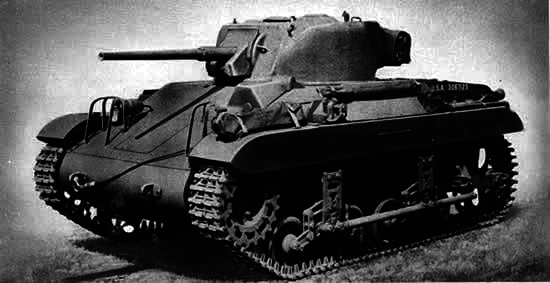
The first airborne US tank - T9, he M22
He passed the first baptism of fire in the Vietnam War, where easy booking and design flaws significantly reduced its combat effectiveness. Despite its widespread use in Europe, in 1970, technical immaturity led to the hasty removal of a tank from production. The only unit of the US Army where it is still preserved is the 82nd Airborne Division. Sheridan was the first tank used in a landing combat operation (Operation Right Cause in 1989, Panama). Most of the “demobilized” M551 before the 2004 year was used as training targets at the landfill site in the Mojave Desert. There have been many attempts to develop an alternative (including the little-known M8 Armored Gun System), but to date, the M551 Sheridan was and remains the last American airmobile tank.
Development M551 Sheridan
In 1958, the Americans curtailed the development program for the T92 light tank, partly because he couldn’t swim. This greatly reduced its value as an intelligence vehicle. In 1959, work begins on creating a new armored reconnaissance-assault-assault vehicle (ARAAV), which was intended to fulfill two roles: reconnaissance in the composition of the armored cavalry units and the reinforcement means for the airborne troops. Special requirements for the new technology were: the ability to swim, low weight for landing and a significant increase in weapons compared with previous developments Т92 / М41.
The developer of the new concept was Cadillac Motors Car - one of the divisions of General Motors. The program started in June 1960 of the year under the designation XM551 ARAAV General Sheridan. The highlight of the new tank was the 152mm XM81 Shillelagh Combat Vehicle Weapon System. The development of this promising gun was launched back in the 1958 year, and it was intended to arm various prototypes of combat vehicles (including the joint US-German development MBT-70). Unlike conventional tank guns, the new system assumed the use of a guided missile as the main ammunition. In many ways, this decision was caused by the conviction of the military leadership that a rocket is much more likely to hit a target than an ordinary projectile. The required armor penetration values were at least 150 mm with the angle of contact of 60 degrees to the normal. Of all the proposed guided missiles, the choice was made in favor of the Shillelagh URC, developed by Ford-Aeronutronic. The use of the missile as the main ammunition also led to a significant increase in the caliber of the gun. The dimensions of the guidance system unit and the warhead significantly limited the minimum size of the missiles of that time, and that was what increased the caliber. In addition to guided munitions, it was assumed the use of conventional projectiles with high-explosive and cumulative filling.
The rocket "Shilleyla" was induced using a semi-automatic guidance system. The gunner needed only to hold the aiming marker on the target, and the rocket course was adjusted automatically for it. She belonged to the so-called second generation of controlled anti-tank weapons. A rocket that is easier to use and less demanding as a gunner, has brought many difficulties to its developers. Basically, difficulties were associated with the need to design a noise-free control system using infrared radiation. Trial launches began in November 1960-th, and the first managed flights - in September 1961-th year.
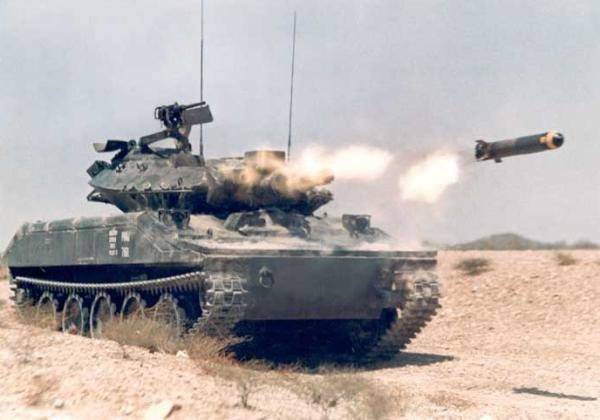
Run Ur Shillelagh
The coming to power of the Kennedy administration in 1961 and the appointment of a new secretary of defense, Robert McNamara, contributed to accelerating the development of Shilleyla. McNamara staked on promising technology. Since the finishing of the M551 Sheridan tank was not completed, an attempt was made to install the complex on the existing M60 tank, which received the new designation M60-X2. The first test launches of the rocket in the fall of 1961, were depressing. Almost one out of ten missiles hit the target. The smoke from spent fuel completely jammed the infrared control channel. I had to initiate a new fuel development program - less smoky.
The problems of a promising weapon system led to a revision of the concept of Sheridan, but, as it turned out from the analysis, the use of existing weapon systems either worsened the estimated combat capabilities of the tank, or unjustifiably overloaded it. Famous foreign missile systems were also far from perfect. The choice was again made in favor of low-pressure guns with the ability to use both conventional kinetic and controlled ammunition.
The finalized rocket showed more satisfactory results, but problems still remained. For example, flight control became impossible if the sun was right behind the control transmitter (in the 40 degrees sector). They drove it to mind for a long time, and only 12 August 1964, the guided MGM-51 Shillelagh anti-tank missile, was finally launched in a limited series. The mass of this solid-fuel rocket was 27 kg, the mass of the warhead - 6,8 kg, length - 1,11 m, diameter - 150 mm, range - 2 km (a little later was increased to three). To determine the combat effectiveness of the new ATGM in February, 1968 produced 112 test launches, achieving 88 hits (79%).
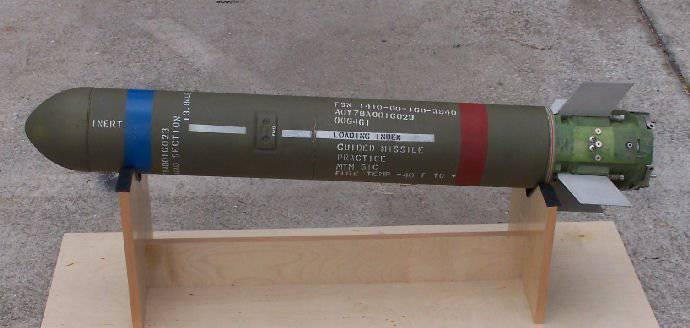
Shillelagh rocket
In connection with the use of completely new weapons, the Sheridan Tower has become the center of attention for developers. The first prototype was a new tower, mounted on the body of the M41. A total of 12 different variations of the experimental XM551 were built. Already in June, the 1962 of the year began factory tests, during which they came to a single layout and design solutions.
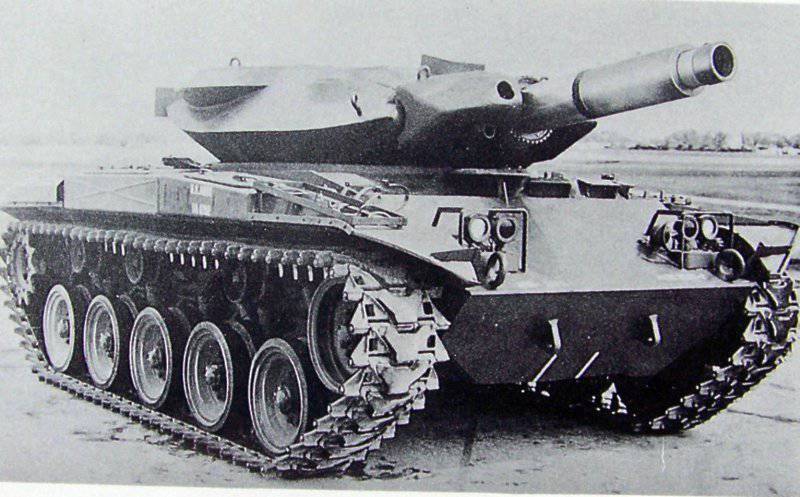
The first prototype XМ551 on the chassis of the light tank М41
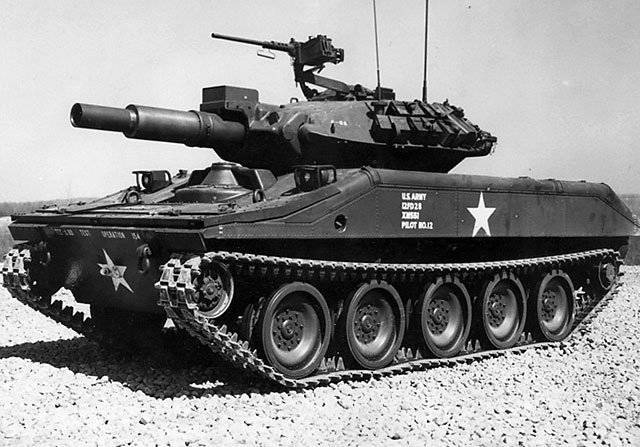
Last, 12 version
What was the result of the new, promising light airmobile tank M551 Sheridan?
Layout
Made according to the classical scheme. All weapons are placed in / on the triple tower, and logistic equipment - in the stern. The driver sits alone in the forward part of the hull, and his hatch, equipped with a sliding cover, is located in the upper frontal part, which, in general, does not matter, since a tank with anti-bullet reservation is unlikely to be saved by strong WLD. The mechanical drive looks at the world through three МNNXX periscopes or two, and a passive night vision device puts in place of the central one. The commander and gunner sit to the right of the gun, and the loader sits to the left. The commander to monitor the combat situation has a commander turret with a circular view through the 47 glass blocks, the loader has the М10 periscope that can be rotated 37 °. Since the buoyancy of the tank was at the level of skimmer, then a special displacement screen was installed on the hull as used in the Second World War on the Shermans, when disembarking in Normandy. Many photographs show boxes placed on the tower, at a glance similar to the blocks of dynamic protection. But no - this is another American layout know-how: a box with cartridges for a machine gun. That will be with them when driving on a rugged terrain or at close explosions of shells, story is silent.
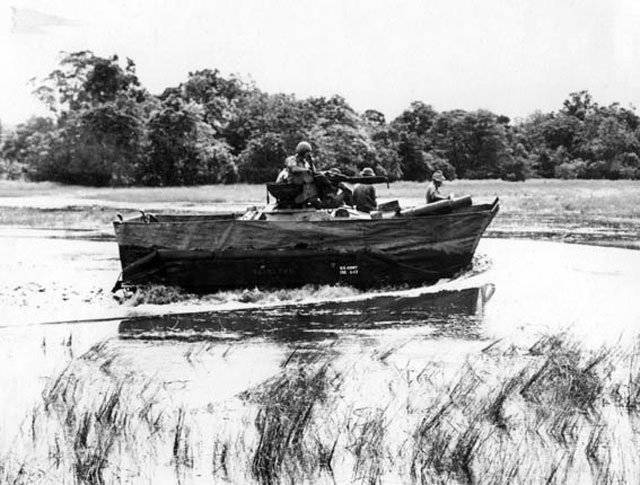
One of two Sheridans purchased for the Australian army crosses a water barrier
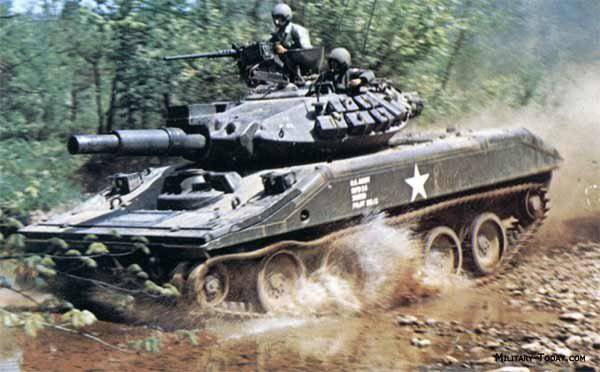
Obviously, placing boxes on armor is not the best idea.
weaponry
Main weapon M551 - 152-mm gun / launcher low ballistics (short-barreled). Structurally: the caliber was limited to the performance characteristics of the Sileila guided missile, and the length of the gun was limited by the mass. The gun system is designed for launches of both anti-tank guided missiles and conventional projectiles. Ammunition was 29 shells or ATGM in any proportions (normally - 10 missiles). The gun was paired machine gun M73 / M219 caliber 7,62 mm, later replaced by M240, ammunition - 3000 cartridges. Also on the tower was installed large-caliber M2 Browning with 1000 rounds of ammunition and the ability to conduct anti-aircraft fire.
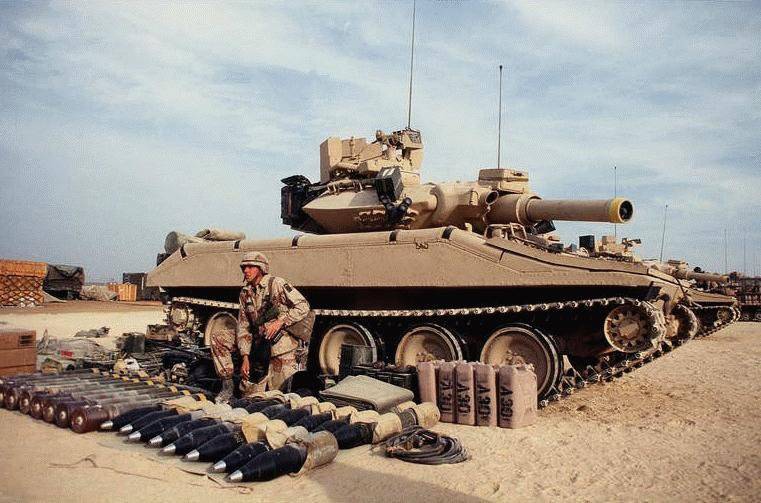
A set of serious arguments
Security Tank reservations due to weight restrictions were extremely weak. The use of composite aluminum armor not only significantly reduced the weight of the machine, but also provided only bulletproof (7,62 mm) and splinter protection. Only the frontal parts of the hull and turret maintained shelling from 20-mm automatic cannons. The tower was made of thin steel armor. Such a weak security has led to a number of field modifications (docking the bottom with a steel sheet, installing the shield on the commanding machine gun).
Mobility. The engine is a V-shaped six-cylinder diesel with a turbocharger 6V53T, manufactured by Detroit Diesel, with an 300 hp power, which, together with a low mass, gives excellent thrust-to-weight ratio 19,7 hp / ton. In this case, the maximum speed of the tank on the roads reached 70 km / h, and afloat to 5,8 km / h. Transmission XGT-250 with four forward and two reverse gears.
Mass production. The start of mass production of the new technology was planned in the 1966 budget of the year, despite significant technical problems and a general flaw in the tank. The premature launch of the combat vehicle series was caused by fears that next year the project would be reduced. As early as March of 1966, a special army test team concluded that such an army tank was not suitable, due to its specific limitations on safe use, reliability and maintainability. Also at 1967, they are testing new items in the tropics and discovering problems with the liners, so serious that the crews were forbidden to load more than one charge into the tank at a time. According to the results of tests, the equipment of the troops with these machines was suspended and hundreds of already released Sheridans were gathering dust in warehouses without work. The fact is that, along with the new cannon for firing conventional shells, new combustible sleeves, developed by Picatinny Arsenal, were used. In contrast to the usual metal, these were made from nitrocellulose. When fired, the powder ignited the combustible walls and the sleeve burned. The main disadvantage of this design was fragility. With the slightest carelessness, the charge broke, and the powder spilled on the floor of the fighting compartment. This and caused the requirement for the process of loading shells. Also, the new ammunition was extremely hygroscopic and, not only did the wet swollen walls not always allow the gun to be properly charged, but also prevented the full combustion of the sleeve. Tankers after a shot to celebrate, threw the next projectile, the smoldering remnants of the previous freelance set fire to the sleeve - and voila, three accidents only on trial. The solution was found original - each ammunition was repacked into a sealed bag that had to be removed before loading. In addition to the new packaging, they also developed a system for blowing the breech after the shot, but then they made a lot of it - the purging was carried out with the shutter open, and sparks merrily flew inside the crew compartment, threatening to set the entire BC on fire. At the end of the epic, they invented new projectiles - M205, with more durable walls and an instrument purge system that operates before the shutter opens - CBSS. The gun system received a new name M81E1, but by that time it had already managed to "rivet" about 700 "explosive" tanks, which they held in warehouses before re-equipment with a purge kit.
Due to the new purge system, the standard amount of ammunition decreased from 30 to 29 projectiles. The initial nomenclature of ammunition involved both smoke and high-explosive fragmentation, but the next design problems left the tank only with a cumulative anti-tank tracer (M409 HEAT-T-MP) and a Shilleyla missile, of course. A little later, in Vietnam they added such “exotic” as shrapnel munition M625, which in principle is quite reasonable for a 152mm short-barreled gun.
The first two M551 Sheridan were made on July 29 1966 of the year, and before 2 in November 1970 made them in the number of 1662 pieces. The tank was officially put on combat duty in June by the 1967. The 1-th battalion of the 63-th armored brigade stationed at Fort Riley was the first to receive them. By the fall of the 1971, the American troops had about 800 units of this armored vehicle. Of which 40 is in South Korea, 310 is in Europe, 250 is in the USA and 200 in Vietnam. The rest were gathering dust in warehouses or waiting for a queue for revision.
In total, 1966 billion dollars was spent on the project from 1970 to 1,3, which exceeded the original budget by 80%. MGM-51 Shillelagh missiles made a little more than 88 thousand pieces, for 2665 $ for each, which added 235 millions to the project budget. Such large numbers of costs for a “raw” and unreliable tank led to discontent in the US Congress. One of the most influential congressmen called this tank: "A billion-dollar error."
Type: light drop amphibious tank.
Manufacturing country: USA.
Consisted on armament: from 1969 to 1996. (in small quantities - to our days).
Mass: 15,2 t.
Length: 6,3 m.
Width: 2,8 m
Height: 2,3 m.
Crew: 4 people. (commander, gunner, loader, driver).
Reservations: aluminum housing, steel tower.
The main armament: M81E1 - rifled 152-mm gun / launcher.
Ammunition: 10 UR MGM-51 Shillelagh, 19 projectiles.
Additional weapons: a twin machine gun M73 / M219 caliber 7,62 mm, ammunition - 3000 ammunition; tower machine gun M2 Browning caliber 12,7 mm, ammunition - 1000 cartridges.
Engine: V-shaped six-cylinder diesel with turbo 6V53T; 300 power l. with.
Thrust: 19,7 hp / ton.
Suspension: torsion bar, independent.
Power reserve: 560 km.
Maximum speed: on the road - 70 km / h; afloat - 5,8 km / h.
Sources used:
Magazine "M551 SHERIDAN: US Airmobile Tanks 1941-2001" by Steven J Zaloga
http://en.wikipedia.org/wiki/MGM-51_Shillelagh
http://en.wikipedia.org/wiki/M551_Sheridan
http://armor.kiev.ua/Tanks/Modern/M551/M551.php
http://www.globalsecurity.org/military/agency/army/1-63ar.htm
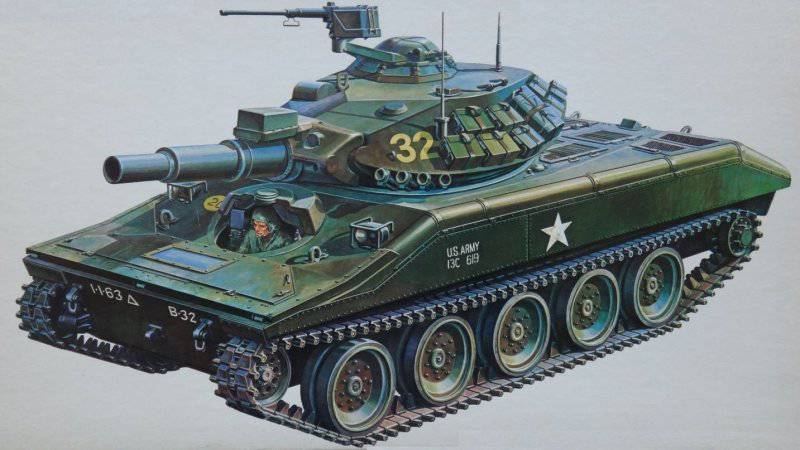

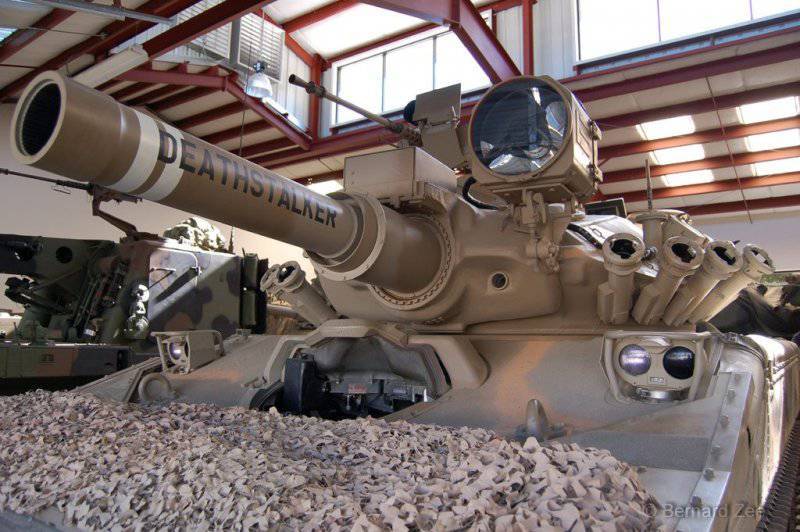
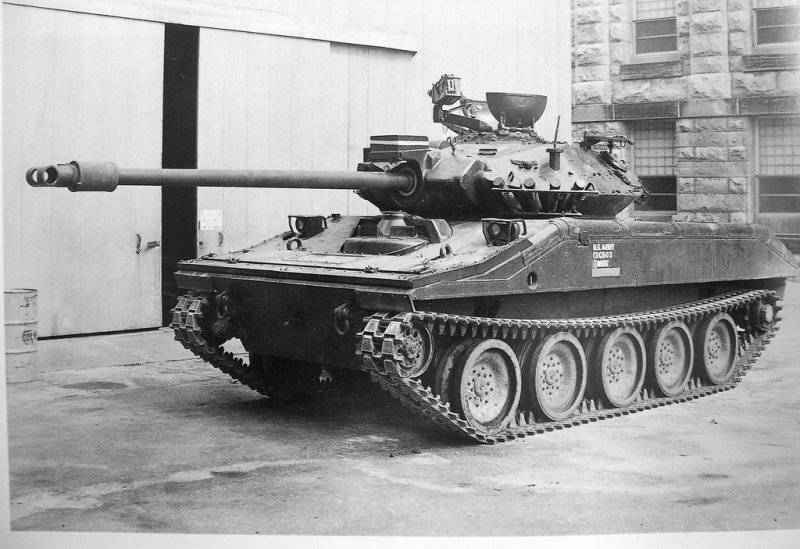
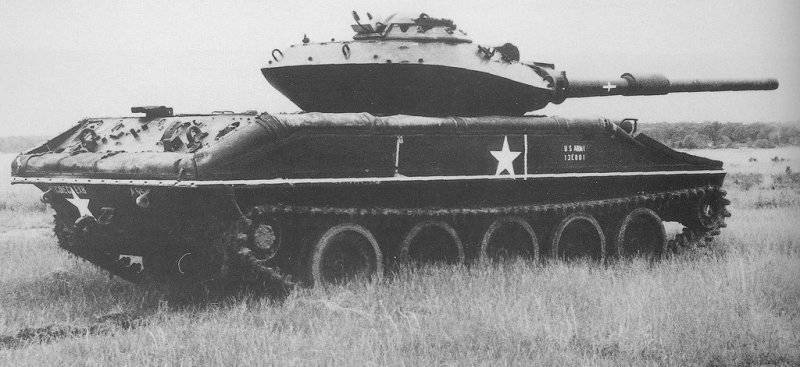
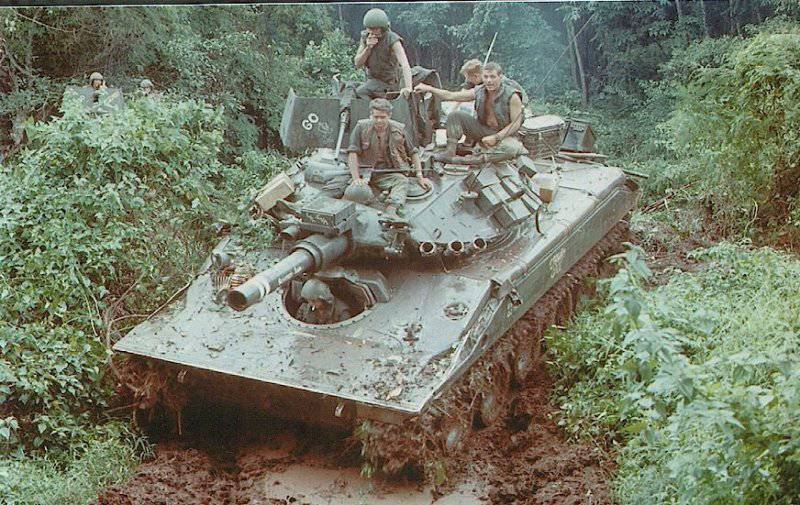
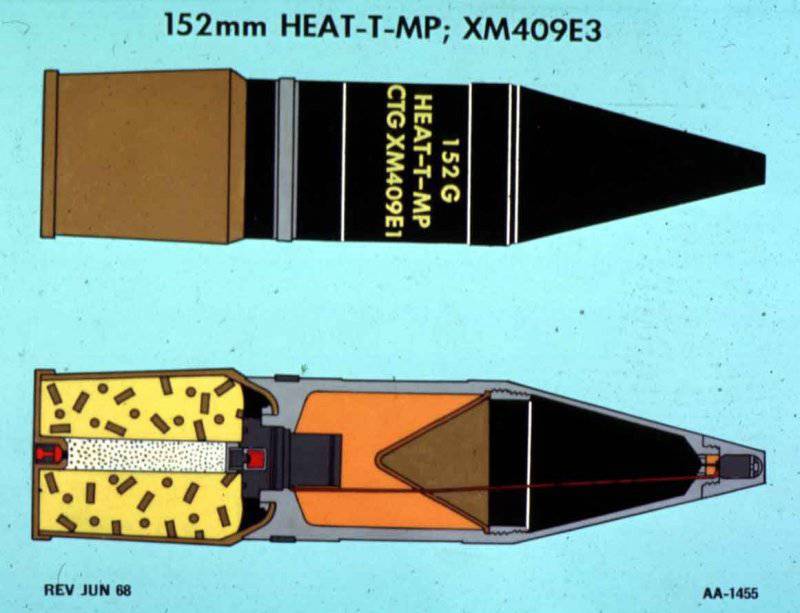
Information